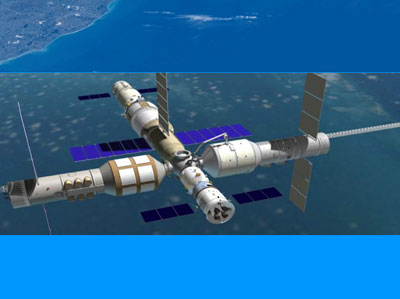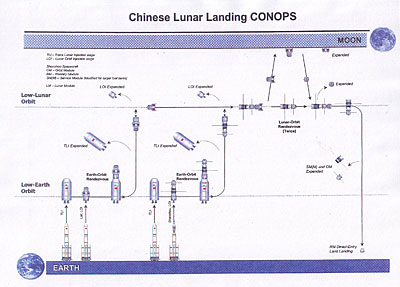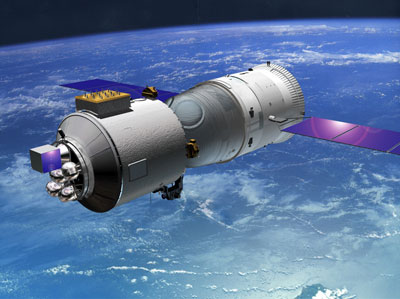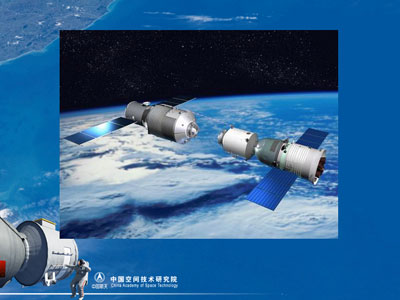The new path to space: India and China enter the gameThe final speaker was Scott Pace, who began his talk by emphasizing that he was not an expert on the Chinese space program but was very familiar with the issue of dual use technologies. Pace devoted much of his talk to China’s possible human lunar ambitions. China has made some impressive advances in human spaceflight with relatively few flights. The United States flew five orbital missions over three and a half years before accomplishing its first space walk during Gemini 4 in June 1965. The Soviet Union accomplished the first ever space walk on its seventh manned mission in March 1965, with four years of human spaceflight experience. China took five years and did it in three missions. Pace noted that China’s 14-minute spacewalk was comparable to the first spacewalks of Russia and the United States (24 and 20 minutes respectively). But he also added that although China had gone from a one-person mission to a three-person mission slightly slower than the Soviet Union and faster than the United States, there is really no good substitute for actually doing things when it comes to spaceflight. China has undoubtedly extensively studied previous American and Soviet extravehicular activities, but there are many things you cannot learn from a book; you have to do them yourself. In addition, claims that China had copied most of its equipment from the Russians were exaggerations and the Shenzhou is approximately 95% indigenously developed and produced.
Pace also offered a brief overview of NASA-Chinese National Space Agency (CNSA) discussions. In December 2004 NASA administrator Sean O’Keefe met with a CNSA delegation and discussed possible cooperation on space applications and Earth and space science. Nothing came of this meeting. In September 2006 NASA administrator Mike Griffin traveled to China where American and Chinese officials discussed regular exchanges between the two countries. Nothing really came from this meeting either and it was nearly another two years—in July 2008—when a NASA team visited CNSA and the two organizations formed two working groups on Earth and space science. Pace said that many in the space community viewed space as a potential form of “ping-pong diplomacy” that could ultimately lead to greater cooperation between the two countries. But in his opinion, this was unrealistic. Space cooperation is dependent on the broader US-China relationship. As long as that relationship is rocky, there will be little or no space cooperation. Pace said that although Chinese technical capabilities are becoming clearer, their strategic intent has not, and several broad questions remain unanswered: Will China develop a human lunar lander? Will China give the Long March 5 (CZ-5) heavy launch vehicle priority over continued evolution of the workhorse Long March 2 (CZ-2)? Will China focus more on robotic systems for disaster monitoring and navigation, among other missions? If China decides to send humans to the Moon, its current most likely method will be to use the Long March 5 booster. First announced in 2001, it is projected to launch in 2014 after numerous schedule slips. Designed to launch heavy geosynchronous communications satellites, it could place 25 metric tons (55,000 pounds) into low Earth orbit or 14 metric tons (31,000 pounds) into a geosynchronous transfer orbit. Pace mentioned that a 2008 paper titled “Research on the Technical Approach of Manned Lunar Mission” (in Chinese) was prepared by Long Lehao, of the Chinese Academy of Launch Vehicle Technology, and Rong Yi, of the Beijing Institute of Space System Engineering. They identified four different approaches to the Moon, most of which require multiple launches of Long March 5 boosters. Two of the methods would require three launches. Pace noted that Lehao is the developer of the Long March 5 and therefore inclined to underemphasize the difficulty of the task. NASA has also developed a notional concept of how China might conduct a human lunar mission and in NASA’s estimation it will require four Long March 5 launches, not three. The first launch would carry a translunar injection (TLI) stage into low Earth orbit. It would be followed by the unmanned lunar landing vehicle, which would automatically dock with the TLI stage and head to the Moon. They would be followed by another TLI stage and then a Shenzhou vehicle which would also rendezvous in low Earth orbit before heading to the Moon. In lunar orbit the Shenzhou would rendezvous with the lunar lander and two astronauts would descend to the Moon’s surface. They would later rendezvous with the Shenzhou and return to Earth. Four launches and four rendezvous events would entail a significant amount of risk, especially for a country with such limited human spaceflight experience. In its current approach to returning humans to the Moon, NASA has sought to minimize the number of launches and rendezvous events.
After Pace’s talk the speakers took questions from the audience, several of which focused upon how much China spends on spaceflight, particularly the manned program, and how obscure their future plans are. Dean Cheng said that although Chinese officials have stated how much they have spent developing Shenzhou, the numbers are effectively meaningless because of the convoluted bureaucracy that is involved in the project. The Chinese may not even know themselves due both to arcane and secretive accounting rules and the way that the program is matrixed throughout various organizations. A better measurement is not cash, but level of effort. Cheng also added that when the People’s Liberation Army was ordered earlier this decade to divest itself of its various commercial holdings such as casinos—part of a plan to “professionalize” the Chinese military—one industry that they did maintain control of was communications satellite manufacturing, which they viewed as vital to their military mission. Pollpeter said that during a recent trip to China, a senior Chinese space official explained that the government was seeking to separate its military and civil space functions which up until now have largely been lumped under the responsibility of the People’s Liberation Army. Although Pollpeter did not offer an explanation for this change in policy, it is not hard to imagine that it is part of the broader effort to increase accountability, professionalism, and clarity in the Chinese military. All that you need to know about the convoluted nature of the Chinese military can be summed up in one name: the People’s Liberation Army Navy. All three speakers agreed that a major problem with China’s space program is its opaqueness. This has been a major complaint in the West, and something that has apparently fallen on deaf ears in China. Openness in Glasgow, and in orbitDespite oft-repeated Western complaints about China’s lack of openness concerning its space program, the reality is that although China is secretive about some of its space projects and plans, including its budget, the country is far more open than many Westerners believe, and certainly far more open than the Soviet Union ever was during the Cold War. There was no better example than the talk given by a member of the Chinese Society of Astronautics during the International Astronautical Congress in Glasgow, Scotland, the week before the AAAS and Heritage discussions in Washington.
The speaker—I do not know his name—demonstrated that in addition to mastering EVAs, the Chinese have also mastered PowerPoint. The presentation includes many detailed computer illustrations of the various Shenzhou vehicles launched to date as well as what are apparently early designs of their future space station modules. The presentation, titled “Shenzhou-7 Mission and Beyond—From Imagination to Reality,” was mostly devoted to recounting the various Shenzhou missions, including the four unmanned missions and their accomplishments. The presentation was remarkably detailed, including a graphic illustrating that five tracking ships, three satellites, and at least nine ground stations supported the Shenzhou 7 flight, a much higher degree of openness than the Soviet Union ever practiced during the Cold War. But the most interesting aspects were the speaker’s discussion of China’s future human spaceflight plans. Up until relatively recently, Western observers have assumed that the next step in the Chinese Shenzhou program would be the near simultaneous launch of Shenzhous 8 and 9 to conduct an orbital rendezvous. This would then probably be followed with the launch of a rudimentary unmanned space station, perhaps in 2010, to be visited by Shenzhou 10.
But according to the presentation at Glasgow, China now has a preliminary plan to launch a target craft around 2011, with an “unmanned spaceship” and a Shenzhou to be launched to conduct a rendezvous and docking test. It is unclear from the presentation if this refers to three vehicles—only one manned—or two. If it refers to three vehicles, then the Chinese may be planning on practicing launching an unmanned “core” vehicle that would be joined by a Shenzhou and could be resupplied with a cargo ship, similar to Russian experience with the Salyut and later Mir space station programs. According to Chinese television—although not detailed in the Glasgow briefing—China might conduct up to three simple space station—known at Tiangong—missions between 2010 and 2015. They would be visited by up to eight Shenzhou spacecraft. If accurate, this means that China plans to gradually increase the pace of its human spacecraft launches. So far China has averaged one manned launch every 2.5 years. It might be at least that long before the launch of Shenzhou 8. But after that, the launch rate could increase to 1–2 missions per year. According to the Glasgow presentation, China would develop a “manned space station” by 2020 “to solve the problem of larger scale space application with manned long-term presence in space.” This is all part of a “three-stage” strategy. Although not fully explained, presumably the first stage was the development of Shenzhou up to the most recent mission. The second stage will consist of the rendezvous and docking with a small space station vehicle and multiple missions extending through at least the first half of next decade. And the third stage will involve developing the “multi-module space station.” Once China has achieved that by the end of the next decade, “China will move to the broad area of the LEO orbit and far beyond.” The presentation slides also state that “we think manned landing on the moon is a great challenge in the global high-tech and is also a strategic field for exploration. So, it is necessary to carry out R&D activities at proper time for the future goal.” But so far as the presentation is to be believed, China’s plans for the next decade focus on extended human spaceflight in low Earth orbit, not a mission to the Moon.
Just as interesting as the words in the presentation are the images, which appear to show for the first time both what may be the Tiangong spacecraft, and an early plan for the multi-module space station that China wants to develop by 2020. The Tiangong module appears to be somewhat akin to the European Space Agency’s Jules Verne Advanced Transfer Vehicle, a pressurized module that could provide supplies to keep a Shenzhou in orbit for perhaps a few weeks. The multi-module space station consists of three large modules mounted around a central hub, with a Shenzhou parked at one of the hub’s docking ports, and what appears to be a module similar to that shown in a previous slide as the docking target—possibly the Tiangong, similar to the Russian Mir space station configuration. Thus, it seems possible that China’s goal is to use the Tiangong to support extended duration Shenzhou missions in the early part of the decade and later to provide logistics support to the multi-module space station. If so, this is a logical stepping-stone approach.
Which brings us back to the Cold War analogy and how little that model resembles the path that China and India are pursuing. China and India are both carefully studying the experience of their predecessors, but setting their own pace. There should not be any real surprise in this. But it does highlight that there may be no “normal” path to human spaceflight. After all, what explains the fact that one of the largest space programs in the world, Japan, never chose to develop its own human spaceflight program? And what exactly determines why a country will choose to develop its own human spaceflight capabilities? Two years ago, at a symposium on the social aspects of spaceflight in Washington, DC, one speaker challenged the notion that countries develop human spaceflight programs in order to assert their capabilities and independence. If this was so, the speaker asked, then what explains the fact that France does not have its own human space program? Every country is different. There is no “normal” path to human spaceflight. Home |
|



